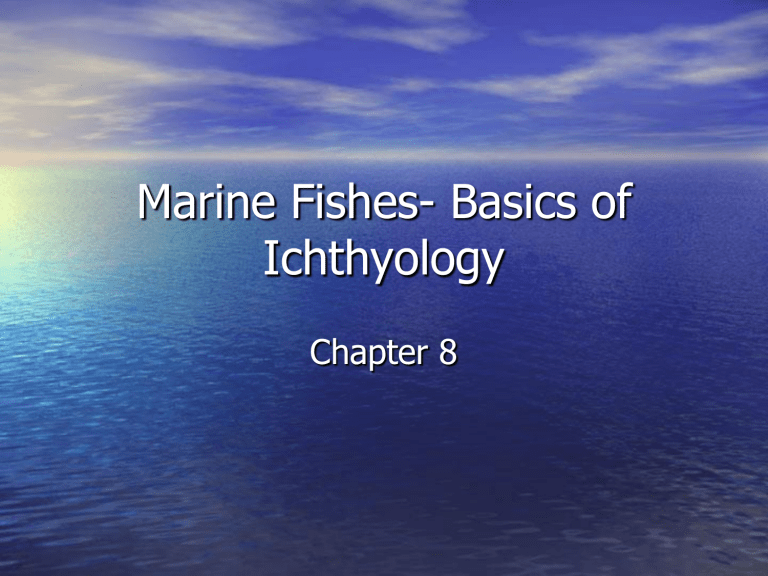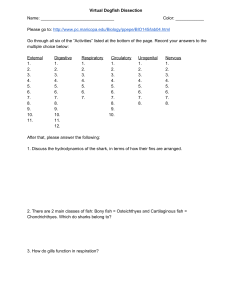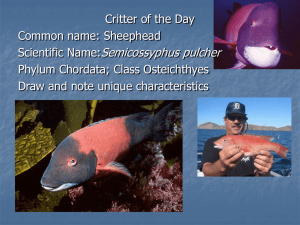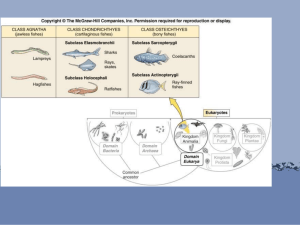chapter_8_powerpoint_im

Marine Fishes- Basics of
Ichthyology
Chapter 8
How are Humans and Sea Squirts related?
2
Subphylum urochordata- sea squirts.
3
Phylum Chordata
• Not all Chordates are vertebrates!
• Characteristics of Chordates:
• 1.) Dorsal nerve cord
• 2.) Notochord
• 3.) Gill slits
• 4.) Post-anal Tail
4
Basic Chordate plan
5
Lancelets- Simple Chordates
6
Subphylum vertebrata
• Have the 4 major characteristics of chordates.
• Also have vertebrae that protect the dorsal nerve cord (spinal cord).
• Bilateral symmetry
• Fish-oldest vertebrates found in the fossil record.
7
Figure 8.01
8
Class Agnatha- jawless fish
• Have no jaws- feed by suction of round mouth.
• Long, slender body (like an eel)
• Lack paired fins and scales.
• Hagfishes- feed on dead or dying fish.
Sometimes bore into their prey and eat from the inside out.
• Lampreys- mostly freshwater- parasitic feeders.
9
Pacific hagfish
10
Pacific hagfish
11
Lampreys
12
Class Chondrichthyes- cartilaginous fish
• Sharks, rays, skates and ratfishes.
• Cartilage skeletons- lighter and more flexible than bone.
• Placoid scales- have a pointed, sometimes sharp tip.
• Caudal fin (tail fin)- top lobe is larger than the bottom lobe. This is called a heterocercal fin.
13
14
Class Chondrichthyes- (cont’d)
• Most cartilaginous fish have two dorsal fins.
• Large, pointed, fleshy pectoral fins.
• Five to seven gill slits on each side.
• Many rows of triangular teeth.
• As teeth are lost, a tooth from the row behind it moves forward.
15
External anatomy of a shark
16
Figure 8.04
17
Galapagos Hammerhead
18
Great White Shark
19
Great White Sharks
20
Bull Shark
21
Bull Shark
22
White tip reef shark
23
Skates and rays
• 450-550 Species
• Mostly demersallive on the bottom.
• Rays have their gill slits on their ventral side.
• Pectoral fins are very large and flat, like bat wings.
• Spiracles aid in gill irrigation.
24
25
Rays- (cont’d)
• Stingrays- Whip-like tail with stinging spines for defense.
• Poison gland produces the venom.
• Bury themselves in the sand and feed upon molluscs and crustaceans.
• Have specialized teeth for grinding shells of prey.
26
Manta Ray and Diver
27
Spotted Eagle Ray
28
Blue Spotted Stingray
29
Southern Stingray
30
Class Osteichthyes- bony fish
• The majority of fishes- 96%. Almost half of all vertebrates are bony fishes.
• Have cycloid, or ctenoid scales- thin, flexible and overlapping. They are smooth to the touch.
• Operculum- a flap of bony plates and tissue that cover the gills.
• Fins- thin membranes instead supported by bony spines, or fin rays.
31
Class Osteichthyes- cont’d
• Mouth is usually terminal (at the end of its head)
• Caudal fin is usually homocercal- both lobes the same size.
• Swim bladder- gas filled sac above the stomach. Helps with buoyancy.
32
External anatomy of a bony fish
33
Body shape of fishes
• Related to its lifestyle
• Streamlined for constant swimming- ex tuna and mackerel.
• Laterally compressed- maneuverabilityaround reefs ex- damselfish, (our fish)
• Flattened- good for demersal fish and rays.
• Eel-shaped – good for living around rocks and for quick propulsion.
• Irregular shapes aid in camouflage
34
Streamlined shape
35
Yellowfin tuna
36
Flattened shape
37
Japanese Flounder
38
Leafy Sea Dragon
39
Damselfish and Tangs- Laterally compresed
40
Eel shaped
41
European eel
42
Coloration
• Chromatophores- special cells in the skin that contain pigments.
Irregular in shape with branches
Some fish can contract and expand the pigment to rapidly change color
• Iridiophores- special chromatophores that contain reflective crystals.
43
Winter Flounder on a checkerboard background
44
Coloration (cont’d)
• Warning coloration- indicates toxins or danger.
• Cryptic coloration- blending in with the environment to avoid predation
• Disruptive coloration- colored bars, stripes or spots that break up the outline of a fish. Intended to confuse predators.
• Countershading- found in open water fishdark on dorsal side, silvery on ventral side.
45
Warning coloration
46
Cryptic coloration- flounder
47
Disruptive Coloration- Four-Eye
Butterfly fish and Ornate Cowfish
48
Locomotion
• Swim with a side to side S-shaped motion using muscles called myomeres.
• Pectoral fins- provide lift in sharks, not in bony fish (why?)
• Dorsal and anal fins- used as rudders
• Pelvic fins- help turn, balance, and “brake”
• Flexibility of fins allow some bony fish to use other methods of swimming.
49
Undulating “S-shaped” swimming- gives the ability to maneuver rocky habitats
50
Tuna swim fast by flexing their caudal fins.
51
Many reef fish use movement of fins to move precisely in feeding habitats
52
This trunkfish can only swim slowly by moving only the end of the caudal fin.
53
Locomotion in cartilaginous fish
54
Locomotion in bony fish
55
Feeding- mouth adaptations
• Sharks- mostly carnivores- often feed on prey larger than themselves.
• Some are filter feeders- whale shark, megamouth shark, manta rays.
• Carnivorous fish-well-developed teeth for catching and holding prey.
• Grazer- feed primarily on seaweeds
• Plankton feeders- filter plankton over structures called gill-rakers.
56
Mouth adapted for taking bites out of large prey
57
Butterfly fish eat very small prey
58
Parrotfish have a beak-like mouth for scraping algae and corals
59
Herring have large mouth for filtering plankton
60
Circulation
• All fishes have a two-chambered heart, located below the gills.
• The first chamber collects deoxygenated blood from the body.
• The second chamber pumps this blood to the gills for gas exchange.
• Fish have a closed circulatory system of arteries, veins and capillaries.
• Sharks- have low blood pressure and use muscle contraction to aid in circulation.
61
Figure 8.15
62
Respiration- irrigation of the gills
• Sharks- most take in water through the mouth AND the Spiracles.
• Skates and rays-spiracles on the dorsal side take in water when on the bottom.
• Bony fish- draw water in by opening and closing the operculum and by the expansion and contraction of the pharynx.
63
64
Figure 8.16b
65
66
Countercurrent system
• Oxygen enters blood by diffusion.
• There must be a lower concentration of oxygen in the blood in order for diffusion to occur.
• The blood in the gills flows opposite to the direction of the water.
• This makes respiration by diffusion more efficient.
67
Figure 8.17d
68
Figure 8.17e
69
Nervous systems
• All fish have a central nervous system.
• Highly developed sense of smell- olfactory sacs on both sides of the head.
• Taste buds- some have them on the fins and skin. Bottom dwellers have ‘whiskers’.
• Lateral line system- allows fish to detect vibrations in the water.
• Chondrichthyes- ampullae of Lorenzinican detect weak electrical fields for locating prey.
70
Lateral Line system
71
Behavior
• Territoriality- when an animal establishes and defends a particular area.
• Territories can be:
• Only during reproduction.
• Permanent- for feeding and shelter.
• Most common in crowded environments.
• Ex.- Damselfish.
72
Aggressive behavior
• Used to defend territories or mating rights.
• Fighting is rare, bluffing is common.
• Open mouths, raised fins, rapidly darting at another.
• Some use sounds, like rubbing bones or fin spines together.
73
Schooling- herring, sardines, mackerel, few sharks and rays.
• Well coordinated, but have no clear leaders.
• Use vision, lateral line, olifaction, and sound to remain in perfect unison.
• Why do fish school?
• Confuse predators by circling or dividing.
• Increase swimming efficiency.
• Advantages in feeding and mating.
74
Traveling schooling pattern
75
Plankton feedingschooling pattern
76
Encirclement of predator- schooling pattern
77
Streaming- schooling pattern to avoid predation
78
Migration- mass movements from one place to another.
• Migration can be daily, yearly, or once in a lifetime.
• Migration can be from offshore to intertidal, up and down the water column, to transoceanic.
• Mostly related to feeding and reproduction.
• Ex.- Open water fish like tuna migrate for feeding purposes.
79
Migration for reproduction
• Anadromous fishes- Spend adult lives at sea, but migrate to fresh water for spawning.
• Salmon- once entering streams to reproduce, they do not feed, and their kidneys must adjust to fresh water.
• Homing behavior- salmon use chemical memory of their home stream and the streams they pass to find their spawning ground.
80
Figure 8.22
81
Migration for reproduction (cont’d)
• Catadromous fishes- Live in fresh water and return to sea for breeding.
• Freshwater eels- live in freshwater and migrate to the Sargasso Sea to spawn.
• Their larvae drift for a year before metamorphosis into adults.
• Possibly use magnetic field and currents for locating spawning grounds.
82
Figure 8.24
83
Reproduction
• Sexes are usually separate. (not always)
• Hermaphrodism-most common in deepsea fishes that rarely encounter another of their own species.
• Sex reversal- Begin life as one sex but change during life cycle.
• ex- sea basses, groupers, parrotfishes
• Anemonefish- all begin as males, one female develops. If she dies, the next largest male becomes female.
84
Reproductive behavior
• Migration to breeding grounds.
• Color changes in bony fishes- salmon eyes turn bright red. Changes in chromatophores can cause skin changes.
• Behaviors- Postures, fin displays and swimming pattern to attract mates.
85
Fertilization
• External fertilization- (broadcast spawning).
Many eggs are produced, can float as plankton or be deposited on the bottom. Most do not survive.
• Internal fertilization- used mainly by cartilaginous fish.
• Oviparous- Egg-laying. Most fishes.
• Ovoviviparous- eggs held within the mothers body until hatching- mostly cartilaginous fish.
• Viviparous- birth to live young that are nourished by the mother- a few sharks.
86
Figure 8.28
87






